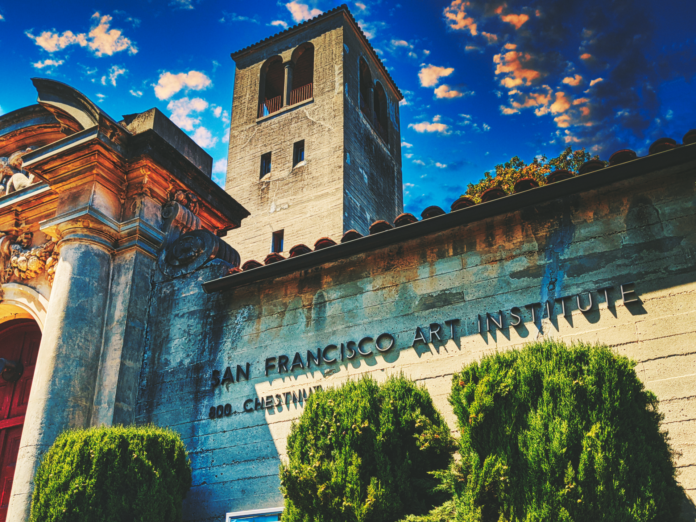The San Francisco art world sees one more beacon fade.
by Max Blue
During the time I studied at the San Francisco Art Institute, from 2014 to 2018, I saw vital neighborhood haunts succumb to the rising tide of gentrification throughout the city. The historic jazz club where I tended bar, Café Melt, and the neighboring artist collective, North Beach Bauhaus, were both shuttered. Friends and fellow students came and went, morale waned, funds dwindled. The only constant was the school itself.
The Art Institute, an amalgam of Spanish colonial and brutalist architecture, is perched on the south side of Russian Hill (the previous campus sat atop Nob Hill), its bell tower rising like a beacon over North Beach. The school has served as a cultural incubator since 1871, producing radical artists and thinkers to wreak havoc on the increasingly bourgeois tastes––often associated with the proximity to Silicon Valley––of a famously counterculture city. From a photography department founded by Ansel Adams came Ruth-Marion Baruch and Pirkle Jones, documenters of the Black Power and hippie movements in the 1960s. The printmaking loft spawned Grateful Dead front man Jerry Garcia and tattoo icon Don Ed Hardy. The painting studios were home to beatnik Jay DeFeo and Obama presidential portraitist Kehinde Wiley.
While my own memories of SFAI revolve around its rich history, which I became versed in as a student worker in the campus library, those recollections are laced with a sense of loss, as I simultaneously watched this vibrant local scene diminish. Sadly, my experience foreshadowed the moment we find ourselves in now. On the verge of celebrating its 150-year anniversary next year as the self-proclaimed “oldest art school west of the Mississippi,” the Art Institute is also on the verge of shutting down. The school issued a statement in March announcing the suspension of its operations at the end of the spring semester, citing the economic impact of the coronavirus pandemic.
SFAI had been struggling financially and facing declining enrollment in recent years. In a last-ditch effort to entice new students, the school opened a new waterfront graduate campus in San Francisco’s Fort Mason in 2016. According to the board of trustees, the new campus did not have the intended effect of increasing enrollment and the school found itself financially overextended. (SFAI administration did not respond to my request for comment.)
I reached out to the school’s longtime librarian and archivist Jeff Gunderson, who has worked there since 1981 and will stay on amid the mass layoffs that constitute the institute’s budgetary response to the pandemic. Gunderson told me that last year the school had just 300 undergraduate and graduate students combined. “Something was going to have to give,” he said. He predicted that online classes and adult education would continue in some form, supported by a skeletal staff to lead fundraising initiatives.
In May, SFAI clarified a few possibilities for the future to SF Weekly. These included artist residencies, bolstered adult education, and a possible merger with another university in the Bay Area in order to sustain the school’s degree-granting programs, a negotiation that was in the works pre-pandemic. How long it will take for SFAI to regain its accreditation, let alone rebuild the student body, remains to be seen.
During the citywide stay-at-home order, arts organizations and universities alike have gone digital. The de Young and Legion of Honor museums are offering digital lectures, virtual exhibitions, and access to internet archives, as are many local galleries such as those housed at Minnesota Street Project and 49 Geary. An institution like SFAI acts as the physical hub of its community and can’t make such an easy pivot to virtual space. As more art viewing spaces go the way of Big Tech, it begs the question: What happens when art making spaces disappear?
“What’s lost is subtle, because you often don’t realize that it’s going on until it pops up somewhere,” Gunderson said. “The best example of this is Barry McGee and Alicia McCarthy and all those graffiti artists. They were doing this stuff and then all of a sudden people realized. They didn’t do it for commercial galleries or museums; it’s sort of like they snuck in.” Both McGee and McCarthy studied at SFAI and were central figures in the Mission School movement in the 1990s. McCarthy went on to teach at her alma mater. “That’s just one example of many,” said Gunderson.
Maybe now, more than ever, l’esprit de résistance of the Art Institute can shine through the darkness, in opposition to its own ending. In April, several arts professionals penned an open letter bemoaning the school’s closure and calling to action fellow players in the local and global art world. The letter describes the “remarkably outsized impact” of SFAI. “That it might cease to exist has caused shock and dismay across the art world, especially here in the Bay Area,” the authors wrote.
Their efforts were partially rewarded. In July, the Art Institute announced it would survive at least one more academic year, having crowdfunded over $4 million and settled disputes with the faculty union. The school invited back students with only two semesters remaining to complete their studies, acknowledging that the future beyond the spring 2021 semester was still uncertain and contingent on sustained fundraising.
Local gallery owner Andrew McClintock earned both a bachelor’s and a master’s from the Art Institute and served as interim director of exhibitions and public programs there from 2012 to 2013. “I have faith the institution will live on,” he said. “In what form it’s not clear yet, but things of beauty never really die.”
But it is the very form of the Art Institute—a physical space, a hub of resistance—that makes it so beautiful. Of the many things SFAI taught me, the most relevant in our current situation is that maintaining communities and histories is a constant practice. Many alumni have come together on social media during this socially distant moment to share memories and seek donations to the school’s emergency fund. In a strange turn, the impending dissolution of the school has brought the community together to once again resist change and stagnation—to keep the lights on, to keep the beacon lit. ♦
Max Blue studied art history and photography at the San Francisco Art Institute and creative writing at the University of San Francisco. His essays and art criticism have appeared in Digital America, Square Cylinder, and the Potrero View, among others. He lives in San Francisco.



